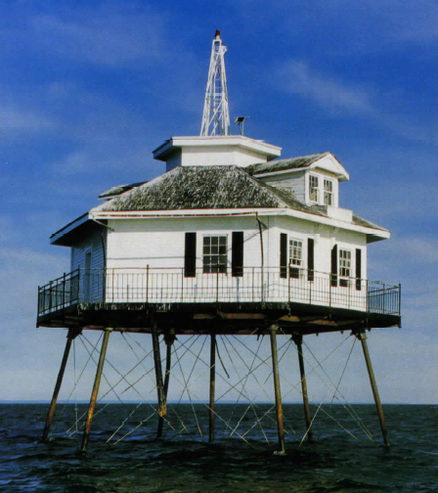
Mobile Bay Light
After the iron tower was removed from Mobile Point, the lens was placed in the Fort Morgan Museum, while the tower itself was relegated to a scrapyard in Pensacola, Florida. There the tower languished until 1977 when resident David M. Smithweck decided to do something about it.
Smithweck, who had seen an article in the Mobile Press Register announcing that the tower was for sale, arranged for the lighthouse to be returned to Mobile Point, and the scrap dealer, Tex Edwards, agreed to deliver it free of charge when he learned of Smithweck's place to donate the structure to the Alabama Historical Commission. Smithweck made the donation in 1977, but funds to restore the tower did not materialize until 1991, when, as part of the two hundredth anniversary of lighthouse service in America, the National Park Service awarded a $25,000 grant toward its restoration and the Alabama Historical Commission provided the remaining funds-nearly $40,000. The refurbished tower now stands in front of the museum building at Fort Morgan as a symbol of the past and a monument to the Mobilians who worked to preserve part of their heritage.
Middle Bay Light
In 1967 the U.S Coast Guard removed the light and declared the lighthouse more of a hindrance than a help to navigation. Local citizens protested, and the lighthouse was turned over to the Mobile Historic Development Commission, which began restoration. Retired U.S. Navy doctor Samuel Eichold initiated a fund-raising drive to restore the deteriorating structure. Listed on the National Register of Historic Places in 1975 and acquired by the Alabama Historical Commission in 1977, the lighthouse is now protected by the Mobile Middle Bay Lighthouse Centennial Commission, an organization formed in 1984 to renovate the structure for its one hundredth anniversary. The Commission, the Propeller Club of Mobile, and more than one thousand community volunteers have contributed to the restoration. Middle Bay Light still lights the bay (with a flashing beacon only), now serving as a channel marker.
Sand Island Light
The island 's first lighthouse was constructed in 1838, when an approximately fifty-two-foot lighthouse was built to complement Mobile Point Light on the opposite side of the entrance to Mobile Bay. Although the rower held a first order lens some fifty-two feet above sea level, it proved to be of little aid to navigation. As a result, construction began on a new 150-foot tower, first lighted in January 1859.One disaster after another quickly followed. In 1861 , when Confederate so ldi ers discovered that the Yankees were spying on Fort Morgan's cannon batteries from the top of the lighthouse, six volunteers rowed to the island and blasted the rower into the water.
The present-day tower was built in 1872, and a two-story lighthouse keeper's house was added shortly thereafter. In 1906 a hurricane deluged the island and swept away the wooden house, killing the keeper and his wife. Disaster struck again in 1919 when a landing party, sent to investigate the reason the light had not shown for two consecutive nights, discovered the lighthouse keepers' quarters empty. An entry in the lighthouse log indicated the keepers had gone to Fort Morgan to pick up a new employee, but they never reached the shores of Mobile Point. In 1947 the light was fully automated. When the new Mobile Point Light took over in 1971, Sand Island Light was finally extinguished. It was added to the National Register of Historic Places in 1975. According to John Sledge, architectural historian with the Mobile Historic Development Commission, the lighthouse is owned by the U.S. Bureau of Land Management, but the agency is seeking a new owner:
"Anyone interested in purchasing the lighthouse," says Sledge, "should be aware of the fact that the site must be opened to the public and made accessible to the handicapped-no easy feat."
This feature was previously published in Issue 35, Winter 1995.
About the Authors
David Smithweck is co-founder and president of the Alabama Gulf Coast Archaeological Society, a nonprofit corporation.
Mindy Wilson, a former Alabama Heritage intern, is a graduate of creative writing from the University of Alabama.
 RSS Feed
RSS Feed